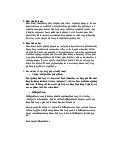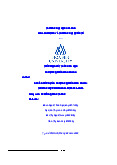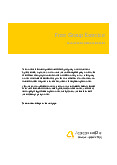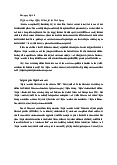



Preview text:
1. POLITICS
1.1. Political structure
France is a republic; the institutions of governance of France are defined by the Constitution,
more specifically by the current constitution, being that of the Fifth Republic.
Though the French constitution is parliamentary, it gives relatively extensive powers to the
executive (President and Ministers) compared to other western democracies.
The head of state and head of the executive is the President Emmanuel Macron, elected by universal suffrage.
The President have more power than leaders of most other European countries, where the two functions are separate. 1.2. Political climate
In April 2022, Macron was re-elected for an additional 5-year term, but abstention reached a
50-year record. The coalition lost its parliamentary majority at the legislative election in June,
policymaking has become more challenging, with bills likely to be passed by decree. The
biggest policy challenge is the program to reform the pension system (abolition of special
regimes), that previously triggered a large-scale national strike and could lead to social unrest.
On the international scene, Russia’s invasion of Ukraine dominated current affairs. Macron
multiplied diplomatic efforts to find a resolution to the conflict and plead for peace during
talks with Russian President Vladimir Poutine.
1.3. Political stability
France enjoys a good political stability. However, it has recently faced a few law-and-order
challenges. Weekly protests over several issues have been very regular in the last few years.
These have disrupted businesses and affected the confidence of both local and international investors badly.
In 2022, after a strong economic recovery from the COVID-19 pandemic in 2021, France’s
economy was hit by an energy crisis driven by Russia’s invasion of Ukraine. Despite its
reliance on nuclear energy and low dependence on Russian gas, France faced a sharp
slowdown in economic activity and high inflation 1.4. Assessment
France is a country with a very important place in the world, with many foreign alliances,
which gives it notoriety and stability throughout the world.
The country also has a key role in the European Union and is a member of the United Nations.
France has a very strong historical presence with a particular emphasis on tourism in the
political sector. Indeed, tourism is always high on the political agenda, regardless of party or
era. Political stability is an opportunity for tourism, as France is one of the most visited countries in the world.
AFFECTE TO THE COFFEE INDUSTRY
Beware, of all the social problems, such as the various demonstrations (yellow waistcoats)
which can disrupt the smooth running and development of businesses and society in general,
by highlighting social inequalities. 2. LEGAL
2.1. Constitution of country
The preamble of the constitution recalls the Declaration of the Rights of Man and of the
Citizen from 1789 and establishes France as a secular and democratic country, deriving its
sovereignty from the people. Since 2005 it includes the ten articles of the Charter for the Environment.
2.2. Components of business laws
The French legal system is based on civil .
law The main rules governing trading companies
derive from statutory law codified in the Civil and Commercial Codes. Most EU legal
instruments are directly integrated into national law and apply between individuals, without
having to be implemented into national law.
2.3. International Trade Agreement
The Government supports a balanced trade policy which ensures the access of French
businesses to foreign markets but preserves collective sensitivities and preferences and
promotes compliance with the Paris Agreement.
France has been a WTO member since 1 January 1995 and a member of GATT since 1 January 1948. 2.4. Assessment
France is a civil law system. Thus, the most important sources of French law are the five basic codes
(Code civil, Le nouveau code de la procedure civile, Code de commerce, Code pénal, and Code de
procedure pénal) and the French Constitution)
AFFECTE TO THE COFFEE INDUSTRY 3. ECONOMICS 3.1. GDP growth
According to European Commission reports, France's GDP increased by 2.6% in 2022, mainly due to
increased imports in the first half of the year, slowed down in the second half of the year by the rise in
raw material and energy prices, which led to a decrease in consumption.
3.2. France trading statistics
France is a country that exchanges a lot of goods with its neighboring countries as well as
internationally. In 2022 we observe an increase in value of exports of 18%, while the value of imports increases by 29%. 3.2.1. Export condition
The French export formalities only concern goods sent to countries outside the European Union or to
overseas departments. In order to export goods, the exporter must fill out an export declaration at the
security office, after which the security office controls the goods and issues the authorization. The
exporter remains the main responsible for the operation until the goods are certified to leave the
territory. The cost of export varies depending on the means of transport chosen. 3.2.2. Import condition
In order to import goods into France, the importing company must be registered with EORI (Economic
Operator Registration and Identification). Afterwards, operators must fill out an entry declaration and
send it to the French importing customs. Import fees include customs duties and VAT.
⇒ Importing or exporting to France is fairly fluid, but there is a fairly significant delay depending on
the period for processing documents for customs. 3.2.3. Trade deficit
France's trade deficit to almost double by 2022 reaching 164 billion euros due to soaring oil, gas and
commodity prices. According to figures published on Tuesday, February 7 by the French Ministry of
Europe and Foreign Affairs, the widest deficit since World War II.
3.2. Labor force and unemployment in country
The unemployment rate in France slightly fell to 7.2% in the fourth quarter of 2022 from 7.3% in the
previous quarter. This was the lowest level since Q1 2008, except for the sharp fall in Q2 2020 during
the first lockdown. The number of unemployed people decreased by 45,000 to 2.2 million. In 2022, 27
728 000 people were in work. The employment rate of the population aged 15 to 64 was 67.3%, the
highest rate since 1975.Unemployment Rate in France averaged 8.38 percent from 1975 until 2022,
reaching an all time high of 10.70 percent in the first quarter of 1994 and a record low of 3.20 percent in the first quarter of 1975. 3.3. Inflation rate
The inflation rate in France in 2022 has reached 5.2%, the highest peak since 2004. This inflation rate
implies a loss of purchasing power, and a general rise in prices (especially energy and raw materials). 3.4. Assessment
In conclusion, France is a country open to others with a high rate of imports and exports, nevertheless
the rate of unemployment and inflation is very high which impacts daily its population. At the same
time, its GDP increased in 2022 thanks to its imports.
1. What is global marketing ?
Global marketing involves planning, producing, placing, and promoting a business’ products or
services in the worldwide market.
There is significantly more to global marketing than simply selling goods and services internationally.
It is the process of conceptualizing and subsequently conveying a final product or service globally.
The company aims to reach the international marketing community.
2. What is international marketing?
International marketing is the application of marketing principles by industries in one or more than
one country. It is possible for companies to conduct business in almost any country around the world,
thanks to the advances in international marketing.
3. What is the difference between the two?
Global marketing means offering different markets the same products and services. International
marketing adapts the products and services to the local environment.
4. What is value chain?
The value chain describes the full range of activities which are required to bring a product or service
from conception, through the different phases of production (involving a combination of physical
transformation and the input of various producer services), delivery to final consumers, and final disposal after use.
5. What is focus strategy?
A focus strategy is a competitive strategy to direct marketing and sales efforts to a specific market
segment. This strategy seeks to exploit underserved or undiscovered segments of a target market.
6. What is standardization? Adaptation? Localization?
Businesses that expand globally need to decide how they'll approach marketing to their new
customers. A standardization strategy delivers a uniform message and consistent content across
markets. Localization takes the opposite approach tailoring strategies, campaigns, and resources at the local level.
7. What is ethnocentric orientation?
A home country orientation or an unconscious bias or belief that the home country approach to business is superior.
8. What is polycentric orientation?
The unconscious bias or belief that it is necessary to adopt totally to local culture and practice.
9. What is regiocentric orientation?
An attitude or orientation toward internationalization with the focus on regional orientation.




